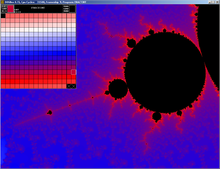Fractint
Fractint is a fractal generator , a program for generating images of fractal geometry. In the version for MS-DOS it was the most popular of its kind in the 1990s, but porting to other platforms did not come close to the functionality of the original. The current version 20.04p14 is dated August 2015.
The strengths of Fractints lie in the variety of available fractal types and setting options: In addition to escape time fractals such as the apple male , iterated function systems (IFS), Lindenmayer systems (L systems) and strange attractors are part of the repertoire; You can also use your own formulas. On the output side, the support of rare and undocumented video modes, which was important in DOS times, stands out, as well as the possibility of saving graphic files independently of the graphic performance of the PC used. Diverse 3D transformations and the support of 3D glasses represent properties that are rarely found even in modern programs.
Due to the popularity of the program, various auxiliary programs were also created by third parties that, for example, simplify the generation of "zoom flights" by the apple man or the design by IFS.
weaknesses
The program dates from the time when everyone was talking about fractals. That was in the early 1990s. The euphoria has subsided and the program has not been fundamentally further developed since then. The following is particularly noticeable:
- The program has not been running under Windows since Windows 7, it was last running under Windows Vista 32 bit.
- The GUI of the Windows user interface is a ported MSDOS version; the usual functions of Windows 95 programs, such as changing the window size by dragging the edge, are missing.
- The program uses only one core on multi-core systems.
- The program does not use the instruction sets of current CPUs.
Measurements on a quad-core processor from 2011 (i5-2300) showed that FractInt uses around two percent of the processor's floating point computing power (Julia amount). Optimized, it could be about 50 times as fast. On workstations with double CPU sockets and current multi-core CPUs, this factor is just under an order of magnitude higher.
history
Fractint originated in 1988 as FRACT386, one by using integer arithmetic on Intel's usually not a floating point coprocessor enacting 80386 processor fast running fractal generator. In 1989 the reference to the processor type was removed by renaming it to "Fractint" and reference was generally made to the calculation in whole numbers (English int eger), this was retained even after the implementation of floating point calculations.
The original author was the mathematician Bert Tyler, later as the head of the so-called Stone Soup Group , which, however, kept the source code available and in the course of time accepted contributions from over 60 programmers.
Web links
Individual evidence
- ↑ Noel Giffin: Fractint: A Little Code, Limitations of Integer Math (And How We Cope) . Nearby Enterprises. Archived from the original on May 19, 2012. Info: The archive link was inserted automatically and has not yet been checked. Please check the original and archive link according to the instructions and then remove this notice. Retrieved May 8, 2012.
